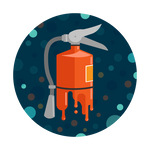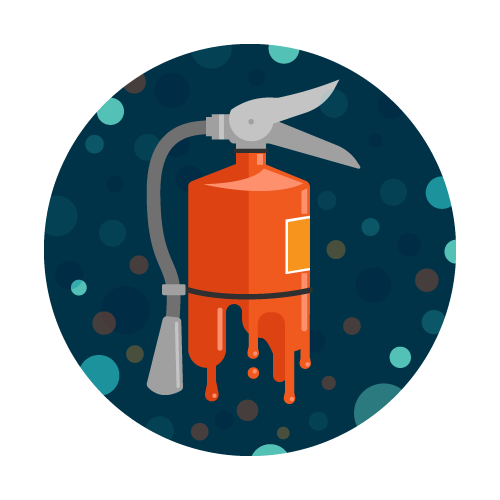
When Can You Trust Water Filter Reviews? A Guide to Red Flags
Our blog is written by real experts— not AI. Each guide is carefully reviewed and updated based on the latest research. Plus, with no affiliate links, you can count on unbiased insights you can trust.
There are tons of water filter reviews floating around YouTube and the blogosphere touting different treatment solutions. Some are helpful, many of them are not. But how do you know which one is which?
We’ve compiled this in-depth guide to common water filter review methods—red flag rating included—to make it easier to determine whether or not to trust a water filter review.
Table of Contents:
- The Red Dye Test
- Comparing Water Clarity
- Taste Tests
- Water Electrolyzers
- TDS Meters
- DIY Water Test Strips
- References to Product Certifications
- Only Testing Post-filtration
- Water Contamination Fear Mongering
- Personal Anecdotes
- Affiliate Links
- The Best First Step to Choosing A Filter
- What's the Takeaway?
The Red Dye Test 🚩🚩🚩
Traditional food colorings have no accredited verification to act as stand-ins for contaminants.
In the “red dye” test, a reviewer pours a colored liquid (typically red food coloring) into a water sample and then runs it through a filter. Videos that use Coke or Pepsi to do this are also essentially red dye tests.
The red dye test is designed to suggest to the average consumer that:
- a) if a water filter can remove food coloring from water, it can remove contaminants (the food coloring acting as a “surrogate” for dangerous contaminants)
- b) water filters that do not remove the coloring are less effective.
There is no correlation between food coloring and dangerous contaminants.
Scientifically speaking, a “surrogate” requires an accredited testing body (e.g. NSF/ANSI—National Sanitation Foundation/American National Standards Institute, more on them later) to have shown—through testing—that the compound in question is an effective surrogate for another. Traditional food colorings have no such verification.
Red dye removal and filter effectiveness have no distinct correlation.
Some filters can be effective at removing red dye while not showing any effectiveness against hazardous contaminants (like PFAS, for example). Some show the exact opposite. There’s no one-size-fits-all test for filter effectiveness that does not involve more rigorous testing methods.
But the water is so clear! Isn’t that a sign that it’s safe? No! The clarity of water doesn’t tell you anything about the many contaminants that are invisible to the eye. Which brings us to the next common review tactic.
Comparing Water Clarity 🚩🚩🚩🚩
The clarity of water tells you very little about its safety
This commonly used marketing tactic shows two samples of water side by side: one clear, and one that is visibly “dirty” or turbid. The turbid water is run through the filter and, once again, crystal clear water comes out.
If the filter is effective at removing enough debris to pour glass of “clean water,” then this should translate to a safe glass of water, right? Not necessarily.
A clear glass of water is not necessarily a safe glass of water.
Just because suspended solids are removed from water does NOT mean that all harmful contaminants in that water have been removed. In fact, most—if not all—concerning drinking water contaminants are much smaller than the visible solids that are removed by this exercise. You can neither see, smell, nor taste substances like arsenic, lead or even pathogens like disease-causing bacteria and viruses.
The Complete Guide to Discolored Tap Water
Taste Tests 🚩🚩🚩
Most dangerous contaminants have no taste or smell at all.
This involves tasting samples blindly and rating them on a scale of, say, 1-5. While fun and engaging, the taste of water is a matter of personal opinion.
Taste itself does not necessarily correlate with water quality.
The taste of water amounts primarily to its mineral content and very rarely to its contaminant level.
Some Common Hazardous Contaminants Without Taste or Smell
- Lead
- Arsenic
- Chromium
- PFAS
- Nitrates
- Microplastics
- Harmful pathogens like Salmonella, E. coli, and viruses
If your water smells or tastes obviously off, avoid consuming it until you can have it properly tested.
The Ultimate Tap Water Taste Guide
Water Electrolyzers 🚩🚩🚩🚩🚩
Water electrolysis is a procedure that has nothing to do with water quality.
Water electrolyzers use positively and negatively charged electrodes to pass an electrical current through a water sample. The small quantity of naturally-occurring salts and minerals (such as calcium and magnesium) in tap water allows it to conduct electricity more easily and break the sample down. Because the electrodes themselves are often made of iron, the iron oxidizes to form ferric hydroxide (or rust), the resulting yellowish-brownish sludge you usually see after the test is conducted. None of this tells you anything useful about your water quality.
Avoid these scams at all costs. Essentially, these devices ruin your water sample in a play to get you to buy a filter. What’s worse, the perpetrators use this scare tactic to target senior citizens. In videos, you’ll often see this paired with a sample of distilled water, the only sample that can withstand the procedure due to its poor conductivity.
TDS Meters 🚩🚩🚩
TDS levels do not equal unsafe drinking water.
TDS meters are very popular among video reviewers looking to add what appears to be scientific proof to their claims. TDS (or total dissolved solids) is the sum of all dissolved ions in a water sample. These ions are typically things like sodium, calcium, magnesium, chloride, and bicarbonate, which are all common—and invisible—in drinking water. TDS meters are dipped into water samples to measure the presence of these substances.
TDS levels do not correspond to contaminant levels.
Typically, reviewers try to correlate low TDS levels with higher water quality, and high TDS levels with contaminated water. This couldn’t be further from the truth. The problem with using TDS as a stand-in for water contamination is that many of the ions measured in TDS are not harmful.
Neither high nor low TDS levels tell you about water quality.
Some waters may have high TDS concentrations but contain only harmless or beneficial ions—like calcium and magnesium, which are necessary to our diets and contribute to a pleasant taste. On the flip side, water samples may be low in TDS but contain hazardous contaminants.

Different samples with different TDS concentrations may all be equally safe to drink if none of the dissolved ions are contaminants hazardous to your health. (In fact, some luxury water brands have begun touting “high-TDS” water.)
It is worth noting that water with very low TDS typically tastes flat due to lack of minerals, so removing all TDS from your water will not improve its flavor either (though very high TDS—typically above 500 PPM—can make water taste salty).
Note: TDS meters are sometimes referred to as PPM meters or “water quality meters.” Both are incorrect. PPM is a unit of measurement that TDS is measured in, so if someone is calling it a “PPM meter” you know they don’t know what they’re talking about. And for all the reasons above, calling it a “water quality” meter is also completely off the mark.
DIY Water Test Strips 🚩🚩
Test strips are only reliable for a very narrow range of parameters.
DIY water test strips are chemical strips that are dipped into a water sample and change color depending on the amount of a particular contaminant present.
Water test strips cannot accurately test for a wide range of contaminants.
Here are some hazardous contaminants test strips simply cannot test for:
- Heavy Metals (lead, arsenic, chromium, copper, etc.)
- Minerals (like flouride)
- Microbial contaminants (Coliform bacteria, Legionella, Giardia, etc.)
- PFAS
- Nitrate(s)
- VOCs
- Pesticides
- Herbicides
- Fertilizers
- Microplastics
- Radiologicals
Test strips are a rudimentary way of gathering data about water quality and not recommended for more serious concerns.
 Apart from featuring a fairly wide margin for error (they can be confusing, messy, and finicky), test strips, by design, cannot test down to the precise levels required for many contaminants that might still be concerning (like the list above). This means you may be led to believe a contaminant is absent—or has been filtered out—when it actually hasn’t. That’s a major concern for long term water use.
Apart from featuring a fairly wide margin for error (they can be confusing, messy, and finicky), test strips, by design, cannot test down to the precise levels required for many contaminants that might still be concerning (like the list above). This means you may be led to believe a contaminant is absent—or has been filtered out—when it actually hasn’t. That’s a major concern for long term water use.
Typically, water test strips are effective for parameters of water chemistry like:
- pH
- alkalinity
- chlorine levels
- H2S (Hydrogen sulfide, or “swamp gas”)
While we’ve covered the pros and cons of using test strips, in short, test strips should not be the only test consulted when choosing a water filter.
The pros and cons of using test strips
The following selections deal with more nuanced issues. It’s important to be aware of what might be omitted from the conversation, and what that might mean for you.
References to Product Certifications 🚩
Water treatment products can only be certified by a handful of organizations, and there’s a lot more to certification than meets the eye.
The National Sanitation Foundation, or NSF (not to be confused with the National Science Foundation), has developed standards for water treatment products in conjunction with the American National Standards Institute, or ANSI.
These standards are meant to ensure that the products are structurally sound, built out of nontoxic materials, and effectively remove the contaminants they claim to remove.
Certification is not centralized or regulated by the federal government.
In the absence of a federal regulatory agency tasked with certifying drinking water treatment devices, certification is handled by various accredited certifying organizations. These organizations use stringent levels of testing and inspection to determine a product’s compliance with specific NSF/ANSI standards for safety, quality, sustainability or performance.
The most widely used accrediting bodies are:
- NSF: (In addition to helping create the standards, NSF is also accredited to certify products) [1]
- WQA: Water Quality Association [2]
- IAPMO: International Association of Plumbing and Mechanical Officials [3]

Certified products will bear the seal of the certifying body.
Finding the certification seal from NSF, WQA or IAPMO is a quick way to ensure that a drinking water treatment device is truly certified to the NSF/ANSI standards they claim.
Nevertheless, certifications in water filter reviews are easily misrepresented.
The Most Common Ways Phrasing Around Certification Can be Misleading
“Tested to NSF standards”
- When a product claims to be “tested to NSF standards,” it is unlikely to be certified to those standards—otherwise they would have stated that up front.
- NSF standards (which are NSF/ANSI standards) and NSF certifications are different. The NSF isn’t the only accredited agency that can certify products, WQA and IAPMO are also legitimate certifying agencies. A certification for a specific NSF/ANSI standard from any of these agencies means that the product was tested to the standard using the full protocol and the product passed.
- Often, when a product claims that it has been “tested to NSF standards” without receiving any actual certification, parts of the standards were not actually met. Testing at two times the filter’s life cycle is a key practice commonly left out. We have seen many filter test results for contaminant removal at points way before the lifetime of the filter is reached, which would never comply with any NSF/ANSI standard. For example, the “independent” lab results may say that the filter test ran for only 50 gallons, but the product claims to effectively filter up to 3000 gallons of water!
“Tested in a certified laboratory”
- The vast majority of labs are certified in some form or other. Laboratories acquire certifications in order to meet different standards of accreditation. Does testing in a certified laboratory certify a product? Absolutely not.
“This product is NSF certified”
- First and foremost, look for the official seal of one of the accredited certifying agencies—NSF, WQA or IAPMO—to confirm a product is actually certified.
- Next, make sure to dig into the details of this claim. There are many different NSF/ANSI certifications, and each standard is different—some are only inspecting the safety of the materials in the filter (e.g., NSF/ANSI 61), while others are assessing efficient removal of certain contaminants (e.g., NSF/ANSI 53).
- Additionally, certifications are given on a contaminant by contaminant basis. This means filters that meet particular NSF/ANSI standards for contaminant removal do NOT necessarily have to remove all of the contaminants covered by the standard. So if a product has an NSF/ANSI 53 certification for lead, it does not necessarily mean it has an NSF/ANSI 53 certification for chromium, PFAS, etc.
- Certification claims are pretty general. Be sure to look into which certification a filter has been awarded, as well as the specifics of that certification. Is it just for materials safety? Is it for contaminant reduction? If so, which contaminant?

If you’re unsure about whether a filter is actually certified, you can search for the specific products in the databases of the most popular certifying bodies—NSF, as well as WQA and IAPMO. [4][5][6]
NSF/ANSI certifications explained
Only Testing Post-filtration 🚩🚩
Unless you test your water before filtering it, you can’t have a clear picture of your filter’s effectiveness.
Sometimes, you’ll find reviewers that run a test on their filtered water. But if you haven’t tested your tap water beforehand, how do you know what the filters removed? Contrary to what is often claimed, tap water is rarely contaminated with toxic cocktails of pharmaceuticals, pesticides and other frightening contaminants.
Performance testing is the only way to measure filter effectiveness.
You might suspect something is in your water, but until you test your tap, you won’t have the full picture. We recommend testing for the most common contaminants like heavy metals and minerals, nitrate(s), and volatile organic compounds (VOCs), and for bacteria if you’re on well water. If your budget allows, test for problems unique to your area. For example, if you’re close to an air force base, it’s a good idea to test for PFAS.
A Great Example of Performance Testing Done Right:
Derek at Modern Castle pits 10 common household pitcher filters against Phoenix, Arizona’s tap water.
What we like: First, he tests his tap water. Then, working from one large sample, he tests the water from each filter pitcher in question. Derek is great at explaining his process every step of the way, allowing viewers to understand what makes for a great filter pitcher—including filter effectiveness and flow rate. He also includes an in-depth blog of the review.[7]
Water Contamination Fear Mongering 🚩🚩
Typically, water concerns are not universal and depend instead on your location and environment.
Despite the news, a lot of America’s tap water is actually quite decent. The vast majority of hazardous water contaminants are very region specific.
So while it’s true that pharmaceuticals and radiologicals can be detected in water, it doesn’t mean they’re all in your water. We know, we test it.
Nitrate(s) may be a concern if you live near agricultural areas; radiologicals like uranium may be a concern near mining operations; arsenic is typically a concern where the water source is an aquifer known to naturally contain arsenic, etc.
The following selections deal with personal experiences and shouldn’t be taken as sole justification for why a particular filtration or treatment technology is better than any other.
Personal Anecdotes 🚩
Everyone’s water is different—what works for someone else may not work for you.
Wholly subjective claims based on anecdotal evidence often sound or read like:
- “I love it!”
- “I/My family have used it for years!”
- “Makes my water taste great!” (read about taste above)
- “Fits great on my counter!”
- “Setup is a breeze!”
All of these can be 100% true but have nothing to do with whether or not the filter is working properly, or can handle what’s in your water.
That being said, taking into consideration how you intend to use your water filtration system and how it will integrate with your space is important. Videos that help you make decisions in this area are helpful.
Be sure you understand how a water filter system addresses your water’s specific needs before you consider how it fits in with the kitchen decor.
Affiliate Links 🚩
Some reviewers will push specific “best filters” because they make money on each sale.
The truth is, affiliate links are the way reviewers make a living doing what they do and there’s nothing wrong with that.
But affiliates are often more interested in pushing out as many reviews as possible, or focusing squarely on products that earn them the most commission. For example, multi-level marketing schemes can be hard to distinguish from honest product reviews. Pay attention to how long the reviews are, and if the reviewer’s methods are described at all.
Refer to the red flags we’ve listed in this article to determine how trustworthy an affiliate review actually is and remember—if a treatment device or water filtration system appears too good to be true, that’s likely because it is.
The Best First Step to Choosing a Filter
Before seeking out information on the different water filter systems that may work for you, it’s important to know what you’re trying to remove from your water in the first place.
Once you know which contaminants you have and which you’d like to remove, you can start looking for treatment products (e.g. filter pitchers, reverse osmosis, ion exchange, etc.) that will help accomplish your water treatment goals.
Take a look at our different water tests and choose the one that’s best for you.
Advanced City Water Test
Ideal baseline for testing tap water provided by a local water utility–including metals, minerals, and chlorine-related byproducts.
Essential Well Water Test
Ideal for regular testing of private or shared well water.
PFAS Water Test
Test your drinking water by EPA 537.1 for PFOS, PFOA, and other PFAS compounds.
What’s the Takeaway?
- Aesthetics (taste, odor, color) and do-it-yourself water parameter tests (like TDS meters or test strips) do not offer a comprehensive picture of your water quality
- When dealing with more nuanced claims (filtration tests, product certifications, contaminant claims, etc.) it’s important to be aware of whether or not they apply to your water’s unique contaminant profile
- Personal experiences and anecdotes should never be taken as sole justification for why a particular filtration or treatment technology is better than any other
Read More
▾Sources and References
▾- National Sanitation Foundation
- Water Quality Association
- International Association of Plumbing & Mechanical Officials
- Search for NSF Certified Drinking Water Treatment Units, Water Filters
- Find WQA Certified Products—Water Quality Association
- IAPMO Product Listing
- Best Water Pitcher Filters (Based on Laboratory Tests)—Modern Castle













